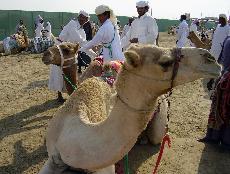Qatari camel racers have eye on Olympics

Camels and trainers prepare before the start of a camel race in Al Shahaniah, Qatar, Wednesday. The “sport of sheikhs” has fanatical support in the area. Eric Talmadge, The Associated Press
December 7, 2006
AL SHAHANIAH, Qatar – Like most everybody else in Qatar, Obeid Nouri has been closely following the Asian Games. He knows that bringing the Olympics to this tiny, oil-rich nation on the Persian Gulf is one of Qatar’s top political ambitions.
As far as Nouri is concerned, however, no international sports competition will ever really be complete until it includes his sport, “the sport of sheikhs.”
Camel racing.
“This is our heritage,” said Nouri, who came to Qatar from Sudan to train racing camels. “It is the sport we all like.”
While the region’s best athletes were competing in the first Asian Games held in an Arab nation, many Qataris were focused on what they consider a more serious pursuit – racing their camels around a dusty 3 1/2-mile track outside this desert village.
Get The Daily Illini in your inbox!
The races are held twice a week, but the ones going on during the Asian Games were especially important. The winners of a dozen or so heats qualified for an international camel race in the United Arab Emirates, one of the biggest races of the year.
Camel races can be chaotic.
At the start, the camels surge off the line in a tight pack, often almost trampling their trainers. The Qatari owners race on a paved road alongside in trucks, using remote controls to transmit commands to robot jockeys about the size of toasters. The robots are armed with whips to keep the camels interested in winning.
To add an element of class, the robots wear colorful cotton jerseys. Some had jockey hats.
“We used to use little boys as the riders until a couple of years ago,” said Mohammed Abdulla, a race official charged with picking out the winners at the finish line. “But robots are better. They are lighter and more precise in their whipping.”
There were also other reasons.
Earlier this year, the rulers of the United Arab Emirates were accused in a lawsuit of enslaving tens of thousands of boys over three decades and forcing them to work as camel jockeys.
The lawsuit was filed in Miami, where members of the royal family maintain hundreds of horses. It alleges Sheik Mohammed bin Rashid al Maktoum, the crown prince of Dubai, and Sheik Hamdan bin Rashid al Maktoum, the deputy ruler, were the most active perpetrators.
The lawsuit claims the boys were taken from other countries, held at desert camps in the United Arab Emirates and other Persian Gulf nations, and forced to work. It also contends some boys were sexually abused, given limited food and sleep and injected with hormones to prevent their growth.
The United Arab Emirates banned the use of children as jockeys in 1993, but boys could still be seen riding in televised races afterward.
The case is still pending.
Still, the sport remains immensely popular in the Gulf states, with some races drawing camels from as far as Egypt.






